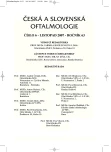Diabetics in Population of Patients Treated by Pars Plana Vitrectomy
Authors:
N. Bezdéšová-Bohunická; Š. Skorkovská; S. Synek; R. Kaňovský; Z. Mašková; M. Synková
Authors‘ workplace:
Klinika nemocí očních a optometrie LF MU a FN u sv. Anny, Brno
přednosta doc. MUDr. Svatopluk Synek, CSc.
Published in:
Čes. a slov. Oftal., 63, 2007, No. 6, p. 431-441
Overview
The purpose of this study is to evaluate visual and anatomic outcomes following pars plana vitrectomy (PPV) for complications of diabetic retinopathy (DR),and to assess risk factors that might influence the visual outcome after successful PPV. The medical records of 35 diabetic patients of both types 1 and 2 of diabetes, who underwent vitrectomy for complications of proliferative diabetic retinopathy (PDR) between 2004 and 2005, were analyzed retrospectively. Certain preoperative systemic and ophthalmic variables, intraoperative variables and postoperative complications with negative influence on visual outcome after PPV were recorded. The postoperative follow-up time was 6 months. The collected data as well as visual outcomes after PPV were statistically analyzed.
Statistically significant visual improvement was achieved in 51.4 % of the patients; visual acuity (VA) deteriorated in 25.7 % of the patients and remained unchanged in 22.9 % of the patients. Preoperative median of VA was 0.0167, changed to 0.1 postoperatively and remained stable on 0.1 level during the 6 months follow-up. VA ≥ 0.1 was achieved in 60 % of the patients 6 months after PPV.
Some of the followed variables associated with deteriorated or unchanged postoperative VA can be considered as risk factors of an unfavorable prognosis. Evaluated risk factors include preoperative VA worse than 0.1, presence of systemic complications of DM accompanying ocular complications, postoperative occurrence of iris neovascularization and neovascular glaucoma.
In conclusion, anatomically successful PPV in diabetic patients is not always followed by an improvement of VA. The optimal timing of vitrectomy is very important not only in order to obtain good visual acuity but also to maintain good visual function for long time. We suppose that an adequate control of DM, sufficient screening for DR and timely laser intervention of DR might decrease the progression of DR and onset of sight threatening complications of PDR as well as decrease the prevalence of blindness at diabetic patients in the future.
Key words:
diabetes, proliferative diabetic retinopathy, pars plana vitrectomy
Labels
OphthalmologyArticle was published in
Czech and Slovak Ophthalmology

2007 Issue 6
Most read in this issue
- Opacification of Hydrophilic Acrylic Intraocular Lenses
- Dry Eye Syndrome in Rheumatoid Arthritis Patients
- Correlation of the Heidelberg Retinal Tomograph, Evaluation of the Retinal Nerve Fiber Layer and Perimetry in the Diagnosis of Glaucoma
- Posterior Capsule Opacification (PCO) Following Implantation of Various Types of IOLs – Part One: The Uncomplicated Course
